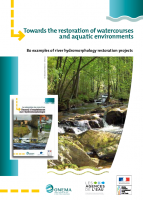Towards the restoration of rivers and aquatic environments - A collection of river hydromorphology restoration examples
The collection presents more than 60 examples of river hydromorphology restoration undertaken over the past 20 years throughout France. These actions aim to preserve river hydromorphology or to re-establish hydromorphological processes of rivers.
The first part of this publication provides basic information on the benefits of restoration, given that river dynamics lie at the origin of biodiversity and good ecological conditions, and the fact that aquatic environments have much to offer society, etc.
Chapters and cards
Many services to society depend on the quality of aquatic environments (Why restore? Part 2)
The natural environment provides many services (also called amenities) to human societies, thus contributing to their development and well-being. The majority of the services provided depend on the conservation status of ecosystems.
River dynamics lie at the origin of biodiversity and good ecological status (Why restore? Part 1)
Transformations of rivers and their habitats are referred to as ”river dynamics” and are explained by physical and biological phenomena.
In order to preserve these phenomena, which are one of the driving forces for the biodiversity of the river system, it is essential to understand river dynamics...
Some examples from the collection
Preservation of the river
Partial or total weir/dam removal
River gravel input
Returning the watercourse to its original bed
Remeandering
Riverbank protection removal
Reopening of a culverted river
Reconnection of side arms
Pond removal or derivation
Improving the ecology of navigable rivers
Le recueil d’expériences sur l’hydromorphologie
| Recueils d'expériences
| January 2021

Le recueil d’expériences sur l’hydromorphologie des cours d’eau, destiné aux acteurs de l’eau et partenaires locaux a pour ambition d’inciter à la mise en œuvre de nouvelles actions de restaurations physiques du cours d’eau. Il regroupe sous forme de fiches, des arguments en faveur de la restauration des cours d’eau et présente plus de 120 exemples d’opérations qui ont eu lieu ces 20 dernières années.

To read on the same subject
Why restore river continuity ? | Book | September 2010
In France, more than 60000 structures - dams, locks, weirs and mills - have been listed on rivers and are potential obstacles to river continuity. Important regulatory texts focus on biological continuity between major natural sites and within aquatic environments. In practical terms, these regulatory texts lead us to increase our collective efforts and actions in favour of restoring river continuity.





